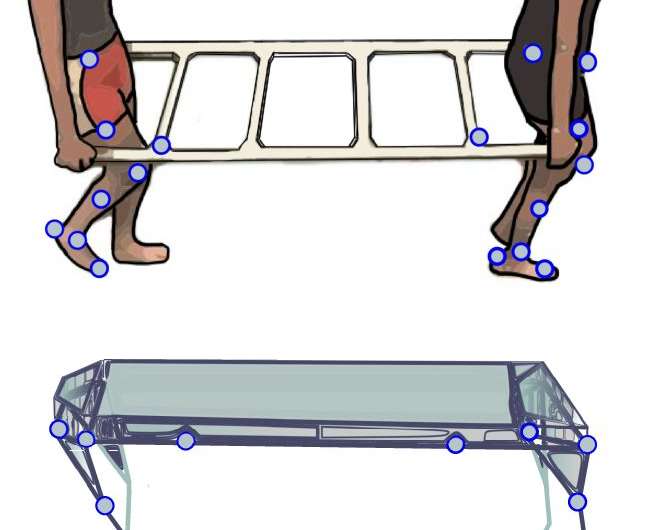People synchronize their walking gaits when carrying a stretcher-like object together

When two people walk one in front of the other while carrying a stretcher-like object, they typically synchronize their gaits, according to a study published September 6, 2017 in the open-access journal PLOS ONE by Jessica Lanini from École Polytechnique Fédérale de Lausanne, Switzerland, and colleagues.
Human walking has been studied extensively, yet there has been less work on how people adapt their gaits while coupled by a mechanical link as in the case of collaborative carrying of an object. Such adaptation could result from the mechanical properties of the coupling, or from high-level strategies such as foot placement.
Lanini and colleagues investigated one case of interactive locomotion: two people walking one in front of the other while carrying a rigid, stretcher-like object between them. The researchers conducted interactive locomotion experiments on six people (four men and two women) who were grouped into 7 pairs, with four trials per pair. Each pair did two trials that entailed walking 12 meters two times (that is, back and forth); and another two trials where pairs were mechanically coupled by carrying a stretcher-like object that was 150 centimeters long and weighed eight kilograms. The researchers analyzed the pairs' adaptation of walking gaits and coordination of foot-fall patterns. In addition, the researchers used a simple model—two bipedal agents connected with a spring-damper—for mechanical analysis of the interactive locomotion.
The researchers found that mechanical coupling changed peoples' walking gaits and reduced step length and the speed of movement. In addition, subjects carrying the stretcher-like object coordinated their foot-fall patterns in more than 70% of the experiments, synchronizing in a way that is reminiscent of quadrupedal gaits.
The simple model predicted some locomotion characteristics of two people coupled by a mechanical link, including the preference for synchronized gaits as well as some foot-fall patterns associated with quadrupedal gaits (in particular, pace and trot gaits). The researchers suggest that the observed synchronization of people carrying objects together can be explained by passive mechanical properties rather than high-level control strategies such as foot placement. However, they also say that other features of the paired walking gait might be related to cognitive and/or psychological effects, and that more complex motor control actions likely should be considered to better understand this phenomenon.
More information: Lanini J, Duburcq A, Razavi H, Le Goff CG, Ijspeert AJ (2017) Interactive locomotion: Investigation and modeling of physically-paired humans while walking. PLoS ONE 12(9): e0179989. doi.org/10.1371/journal.pone.0179989
Journal information: PLoS ONE
Provided by Public Library of Science




















